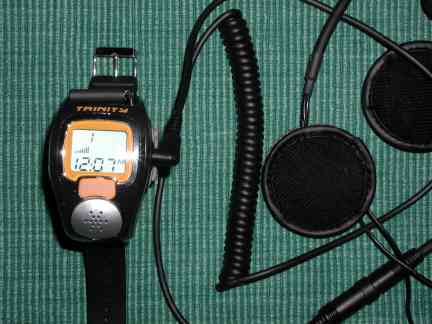
Watch Talker
This is
a small miniature uhf 40 ch CB transceiver worn on the wrist .It is self
contained and runs off a 570mAh 3.7 v lithium ion battery. The unit has an 3.5mm
earphone socket configured with tip mic ring speaker and sleeve
earth, the earphone socket is also used for charging the internal
battery. The antenna is a small 25mm long helically loaded unit that folds up
from the top of the case.

The
radio was dismantled easily the back coming off
after removing two screws and hinging to show the transceiver circuit
board. The battery is contacted from inside by two spring contacts.
The two screws holding the circuit board and antenna were removed an the circuit
board removed completely .A short length of teflon RG 174 50 ohm coax
terminated in a male BNC was soldered to the antenna contact ring and the
braid earthed onto a conveniently close earth.
The unit
was connected to a current limited variable voltage power supply, current limit
set to 500mA and voltage at 3.7 to simulate a charged Lion battery though the
unloaded voltage of the battery was 4.15 volts! On connection the radio started at 26mA which after a second dropped back to 20 mA
after a few seconds the current
readings dropped rhythmically to under
12 mA the receiver dropping into standby mode.
The
radio was connected to the HP8656 signal generator at 476.425 MHz UHF CB (ch 1)
the squelch opened at -113 dbm ( just under 1uV terminated) not exactly
crash hot, though I don't know if this model radio had its synthesiser
reprogrammed for Australasian ch and the component values in the front end were
still at 467 MHz (USA FRS Freqs). This may account for the poor sensitivity.
Still one microvolt is not too bad. however I feel the transmit/receive
performance will be let down by by the very small inefficient antenna.
The BNC was swapped off the sig genny and place into the Agilent E 4403B
spectrum analyser. The transmitter was keyed by the ptt button .At 3,5 V the
unit drew 170 mA and was generating +20 dBm (100mW) .The power supply was turned
up to 4.00 v to simulate a fully
charged battery, and the Transmitter keyed. This time it drew 310 mA and put out
+26 dBm ( 400mW) so not a bad
output for a small radio
transmitter. I performed a full 3.0 GHz sweep to look for spurious harmonics of
the transmitter and was impressed to see all were at least 65 dB down on the
fundamental.
Looking
at the pc board there was a large
LSI receiver /transmitter chip with the numbers AN6311FA 408c3809
,crystals 4.194 MHz and 20.950 MHz and
a MC34119 audio amp chip the
frequency trimming capacitor was close to the 20.950 xtal and the squelch pot on
the display side of the pc board next to the 455 Kz IF can
Yes we have a headset to suit this radio as well !
Want to go back to Motorcycle communications? ...... click here!
Pinfold Health Services Ltd,1172 Arawa St, Rotorua 3201,New Zealand. ph +64-7-3488850 fax +64-7-3486555 pinfold@xtra.co.nz